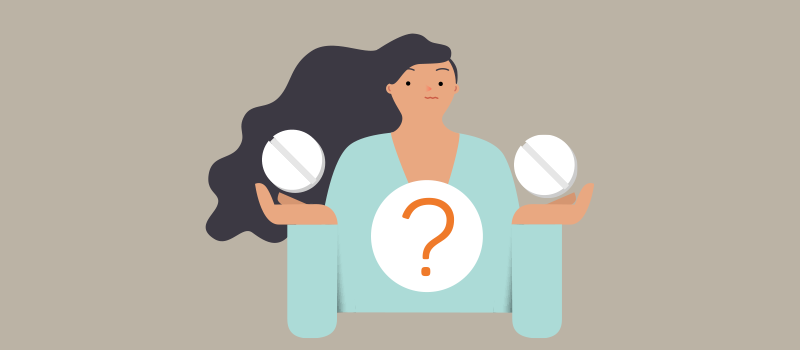What’s the Buzz
The Bee Healthy Blog
Similarities and Differences Between Antibiotics

Antibiotics are medications used to treat bacterial infections, such as urinary tract infections, lower respiratory tract infections, including pneumonia and bronchitis, and others. There are various types of antibiotics available. Each antibiotic class is effective against certain types of bacteria or certain groups of bacteria.
Please continue reading to learn about some of the similarities and differences among various antibiotics. We will focus on one antibiotic called ciprofloxacin - an antibiotic in the quinolones class. Ciprofloxacin is also known as Cipro, one of the brand names; this medication is available as a tablet and oral suspension. We will discuss its uses, adverse effects, drug interactions, and some precautions to take while being on ciprofloxacin.
What types of antibiotics are used to treat bacterial infections?
There are various types of antibiotics available to treat bacterial infections. Each antibiotic is effective against certain types of bacteria; for example, ciprofloxacin is effective against Escherichia coli and Pseudomonas aeruginosa. Therefore, healthcare providers select an antibiotic based on which bacteria is the likely cause of your infection and if you get infected while you’re being hospitalized or not. You might also have heard of the term “broad-spectrum antibiotics.” These agents are effective against a wide range of Gram-negative and Gram-positive bacteria. Your doctor will generally choose a broad-spectrum antibiotic for the empirical treatment before narrowing down to the causative bacteria through blood and urine cultures.
The following are some of the major classes of antibiotics and their uses:
- Aminoglycosides are reserved to treat serious infections caused by Gram-negative bacteria. Examples of this class of antibiotics are gentamicin, tobramycin, neomycin, streptomycin, and amikacin. These antibiotics can be used to treat severe infections of the urinary tract and the abdomen, as well as bacteremia and endocarditis, which is a life-threatening inflammation of the heart valves’ lining. Hearing loss and kidney injury are the adverse effects of aminoglycosides.
- Carbapenems provide broad-spectrum coverage and can only be given by injection. Examples are meropenem, ertapenem, doripenem, and imipenem. They are used to treat complicated bacterial infections, including sepsis, pneumonia, and gangrene.
- Cephalosporins like cefazolin, cefaclor, cephalexin, cefdinir, cefuroxime, and ceftriaxone. They are effective against a wide range of bacteria, with the oral agents being used for mild to moderate skin and soft-tissue infections and the injectable agents being effective in treating much more serious infections such as meningitis or infections that are acquired in a hospital.
- Fluoroquinolone antibiotics include ciprofloxacin, levofloxacin, ofloxacin, moxifloxacin, delafloxacin, and gemifloxacin. Fluoroquinolones provide broad-spectrum coverage that is effective against many different types of bacteria. These antibiotics are used to treat moderate to severe urinary tract infections, lower respiratory tract infections, such as pneumonia and bronchitis, as well as prostatitis and sepsis.
- Glycopeptides and lipoglycopeptides’ most commonly used agent is vancomycin. They are used to treat life-threatening infections caused by multidrug-resistant bacteria.
- Macrolides, such as azithromycin and erythromycin, are commonly used to treat respiratory infections like sinusitis, pharyngitis, tonsillitis, and pneumonia.
- Penicillins are easy to identify because of their “-icillin” ending and include ampicillin, amoxicillin, nafcillin, dicloxacillin, carbenicillin, penicillin V, and penicillin G. They are used to treat respiratory, ear, skin, mouth and throat infections and their use is very broad.
- Sulfonamides are our “sulfa drugs,” such as sulfamethoxazole, sulfamethizole, sulfadiazine, and sulfasalazine. These antibiotics are able to concentrate in the urine, which makes them effective in treating urinary tract infections.
- Tetracyclines are a category that contains minocycline, doxycycline, methacycline, lymecycline, and rolitetracycline. They are used to treat respiratory, skin, eye, intestinal, genital, and urinary tract infections.
There are more classes of antibiotics than mentioned above. Consequently, there are even some antibiotics like clindamycin, mupirocin, metronidazole, fosfomycin, and nitrofurantoin that do not fit into any drug class.
Is ciprofloxacin a penicillin?
As we stated above, ciprofloxacin is not a penicillin. It is a broad-spectrum fluoroquinolone antibiotic.
What is ciprofloxacin used for?
Ciprofloxacin has a broad spectrum of use. It is FDA-approved to treat urinary tract infections; sexually transmitted infections like gonorrhea; prostate gland infections; skin infections; bone and joint infections; gastrointestinal infections; typhoid fever; sinus infections; bronchitis; lower respiratory tract infections; and infectious diseases. Ciprofloxacin is also prescribed to patients with mixed infections, which means gram-positive and gram-negative infections.
Remember, antibiotic treatment is not effective against viral infections like the common cold and flu.
How to use ciprofloxacin?
Dosage forms
This medicine is available as immediate-release tablets, extended-release tablets (Cipro XR), and oral suspension. You should not substitute one type of ciprofloxacin for another.
Ciprofloxacin dose
Ciprofloxacin tablets and ciprofloxacin suspension are usually taken twice a day. The extended-release tablets are usually taken once daily. Take your medicine around the same time every day. The dose and duration of your treatment with ciprofloxacin will depend on the type of infection. For example, 250 mg twice a day for 7-10 days for uncomplicated urinary tract infections and 500 mg twice a day for 7-14 days for complicated urinary tract infections. The dose in pediatric patients depends on the child’s weight.
Administration
Do not crush or chew the tablets. Swallow them whole. If you need to split a tablet, break it along the score line. Do not cut, split, crush, or chew the extended-release tablets—make sure you swallow them whole. Shake the bottle of ciprofloxacin oral suspension well before use. Measure the correct dose using a dose-measuring device. Swallow the suspension without chewing the granules it contains.
Precautions
Follow the directions on the prescription label carefully. Do not take more or less of this medicine than you have been prescribed. Also, do not take it for a longer or shorter duration than prescribed. Prolonged therapy with antibiotics can put you at risk of serious adverse effects. Ask your doctor or pharmacist if you don’t understand how to take ciprofloxacin.
If you miss a dose, take it as soon as you remember. However, if it is almost time for the next dose, skip the missed dose and take the next dose according to your regular dosing schedule.
You will likely start to feel better after the first few days of ciprofloxacin treatment. Tell your doctor if your symptoms do not improve or worsen. Do not stop taking ciprofloxacin until you complete the entire course prescribed by your doctor, no matter how well you are feeling. Stopping ciprofloxacin too soon or skipping doses can lead to incomplete treatment of your infection. It can result in not clearing your current infection completely or antibiotic resistance, making future infections harder to treat.
Talk to your pharmacist about how to dispose of unused medicine so that children, pets, or others cannot get to it.
Is ciprofloxacin a strong antibiotic?
Yes, ciprofloxacin is considered a “strong” antibiotic. It belongs to a group called broad-spectrum quinolone antibiotics that have proven therapeutic efficacy against a wide range of bacteria. It is available as an oral tablet and oral suspension, so it is very useful for pediatric patients and adults with swallowing problems
What are the risks of ciprofloxacin use?
Like most medications, ciprofloxacin can cause side effects. Common side effects include heartburn, stomach pain, nausea, vomiting, diarrhea, headaches, and drowsiness.
Ciprofloxacin can also cause serious side effects, including nerve damage leading to peripheral nephropathy, tendon rupture, muscle weakness (potential signs of myasthenia gravis), low blood sugar, and severe mood and behavioral changes leading to the worsening of existing mental illness. Other serious side effects to watch out for are seizures, liver damage, and prolonged QT interval, which can increase the risk of abnormal heartbeat. Stop taking this medication and let your doctor know immediately if you experience any signs and symptoms of these serious side effects.
Symptoms of tendon problems to look for are stiffness, unusual pain, and new popping sounds, which can be signs of tendon rupture. Make sure that you rest the afflicted joint until you can be examined by a healthcare professional.
Even though they are not extremely common, ciprofloxacin can cause damage to your aorta - this is a medical emergency as it can cause life-threatening bleeding. Signs to look for are constant, severe pain in your back, chest, and stomach.
Same as other medications, ciprofloxacin can cause allergic reactions. Seek emergency medical help if you develop signs and symptoms of an anaphylactic allergic reaction, such as skin rash, difficulty breathing, or swelling of your face or tongue. Call your healthcare provider and get medical help in case of a ciprofloxacin overdose. The poison control center website also has useful information in case of an overdose.
What should I avoid while taking ciprofloxacin?
Certain other drugs
Ciprofloxacin can have drug interactions with certain other medicines. In other words, certain drugs can affect ciprofloxacin and make it less effective or worsen the side effects. Combinations of certain drugs with ciprofloxacin can increase the risk of serious adverse reactions. This includes common over-the-counter pain relievers called NSAIDs (nonsteroidal anti-inflammatory drugs). Taking an NSAID such as Advil (ibuprofen) with ciprofloxacin can enhance neurological side effects, such as seizures and tremors.
If you are taking antacids (Mylanta, Maalox, Tums, others); calcium, zinc, or iron supplements; phosphate binders like sevelamer (Renvela, Renagel); didanosine (Videx) solution; sucralfate (Carafate); or lanthanum carbonate (Fosrenol), make sure to take ciprofloxacin at least 2 hours before or 6 hours after these medications. Taking ciprofloxacin at the same time as these medications can make ciprofloxacin a lot less effective.
Give your doctor or pharmacist a complete list of your medications, including prescription drugs, over-the-counter medications, herbal remedies, and dietary supplements, to avoid possible drug interactions and adverse events.
Certain foods and drinks
Ciprofloxacin is to be taken by mouth, with or without food. Do not take ciprofloxacin with dairy products, nutritional supplements containing calcium, or calcium-fortified juices alone. However, you can take ciprofloxacin with a meal containing these foods and drinks.
Avoid caffeinated foods and drinks, such as coffees, teas, colas, chocolate, and energy drinks, while on ciprofloxacin. The combination of ciprofloxacin and caffeine can worsen side effects like insomnia, nervousness, pounding heart, and anxiety.
Avoid becoming dehydrated while on ciprofloxacin, especially if you have a history of renal impairment or kidney disease. Drink plenty of water and stay well-hydrated while on this antibiotic.
UV light
Avoid prolonged sunlight exposure or exposure to sun lamps or tanning beds while on ciprofloxacin. Wear protective clothing, sunglasses, and sunscreen when outdoors. This antibiotic can increase your skin’s sensitivity to ultraviolet light. Tell your doctor if you develop red, swollen, or blistered skin (like a sunburn).
References:











SOCIAL